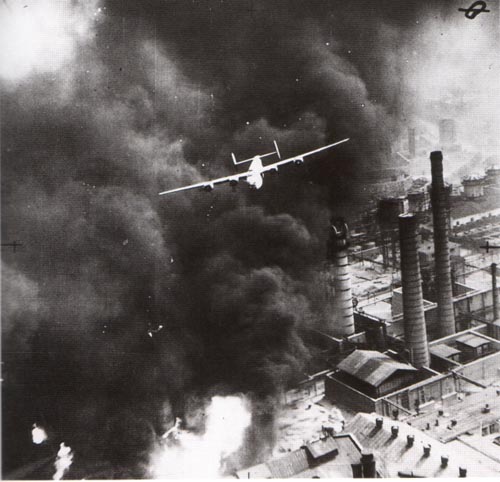
Far to the southeast of the other main targets of the strategic air war, the Fifteenth Air Force, with some British help, waged its own campaign against the refineries and transportation facilities around Ploesti. The British effort, although inconspicuous, was more important than it seemed at the time. Starting in April the RAF’s 205 Group had begun dropping mines in the Danube, which carried about a third of the oil produced in Romania to the Reich. The Germans tried elaborate countermeasures, including a squadron of transport planes equipped to sweep magnetic mines from the air. (Ironically, they foolishly grounded the unit as gasoline grew short.) The mines sank many ships and barges and largely halted river traffic. RAF night intruders also strafed and destroyed some oil barges.
The Americans continued a long and difficult campaign against the oil source. General Gerstenberg was still in command at Ploesti and operated as Geilenberg’s local counterpart. On May 5, after the oil campaign had been formally approved, the Fifteenth attacked the marshalling yards and oil installations for the fourth time. The Germans tried a large-scale smoke screen but this time it was not particularly effective. An attack on May 18 was partly aborted because of bad visibility, however, and one on May 31 was an outright failure because of the smoke. Despite this, production at Ploesti fell from 370,000 tons, a month before the attack, to 160,000 tons in May.
An attack on June 6 was rated a success, but the Americans were sorely puzzled by the growing effectiveness of the smoke screens, while the Nazis took increasing control of the rebuilding effort from the faltering Romanians. On June 10 the Americans tried a new tactic; 36 P-38s went under the smoke to dive-bomb the refineries while others covered them. Three refineries were hit, but 24 P-38s were lost to intense opposition from fighters and flak, while only ten Me-109s went down. Although this was one of the Germans’ few successes in fighter-versus-fighter combat, the loss was a high proportion of the defending force in Romania, and some observers thought there was a slackening of resistance thereafter.
The fighter-bomber experiment was not repeated. Instead, the heavies shifted their attention to other oil and transport installations in Romania. On June 23 and 24 the Fifteenth bombed Ploesti blindly through the smoke. Production in June fell to 75,000 tons. The Fifteenth got ready to launch H2X missions (it had just received the necessary equipment), while it attacked oil installations at Bucharest and at Brasov, north of Ploesti. On July 9 it returned to Ploesti, using H2X for the first time to peer through the smoke screen. The results of this first radar mission were not especially good; they proved better on July 15 but less successful on July 22. On July 28 a new tactic to aid visual bombing was introduced; a master bomber like that used by the British at night flew ahead in a P-38 to see where the smoke screen was thinnest. Instead of being bound to strike a predetermined target, the bombers were directed to those refineries that were most exposed. This worked well, and worked again on July 31.
Smoke and skilled repair efforts had raised overall production in July to 190,000 tons, but this was Gerstenberg’s last success. By late July fighter resistance was definitely in decline, while cumulative damage from the more accurate bombing was beginning to shut some refineries permanently. When the Fifteenth returned to Ploesti on August 10, the bomber force could afford to string itself out in a long stream. By the time the later groups arrived, the smoke screen had thinned out.
On August 17-19 Allied attacks cut production to 10 percent of the March level. These last blows were designed more to stop the enemy from carrying off machinery than halt production; the Germans were about to leave Ploesti. On August 20 the Soviets began a major offensive in Romania and swiftly encircled much of the defending force, and Romania jumped over to the Allied side. On August 30 the Soviets entered Ploesti to find a shambles.
The air campaign against Ploesti had lasted just over four months. Despite the early Soviet capture of the area, it had been worthwhile, denying the Nazis at least 700,000 tons of oil products. (Some estimates run considerably higher; the Ploesti campaign results were less thoroughly recorded than other aspects of the oil struggle.) The Americans had also helped the Soviet advance by pinning down fighters and flak in defense of Ploesti and damaging rail installations behind the Axis front.
The Fifteenth had dropped 13,469 tons of bombs on oil installations and related transport targets to achieve this, and its cost in lives and planes had not been small. The Americans had lost 223 heavy bombers, 24 fighter-bombers, and 28 escort fighters, while the RAF had lost 38 bombers at night. Because of the German fighter resistance over Ploesti, Vienna, and some other southern targets, the Fifteenth had had a much higher rate of loss than the Eighth. It lost almost as many bombers in the summer of 1944 as the British-based force, which was twice as big. The men of the Fifteenth sardonically composed a ditty, sung to the tune of “As Time Goes By”: “It’s still the same old story, the Eighth gets all the glory, while we go out to die. The fundamental things apply, as flak goes by.”